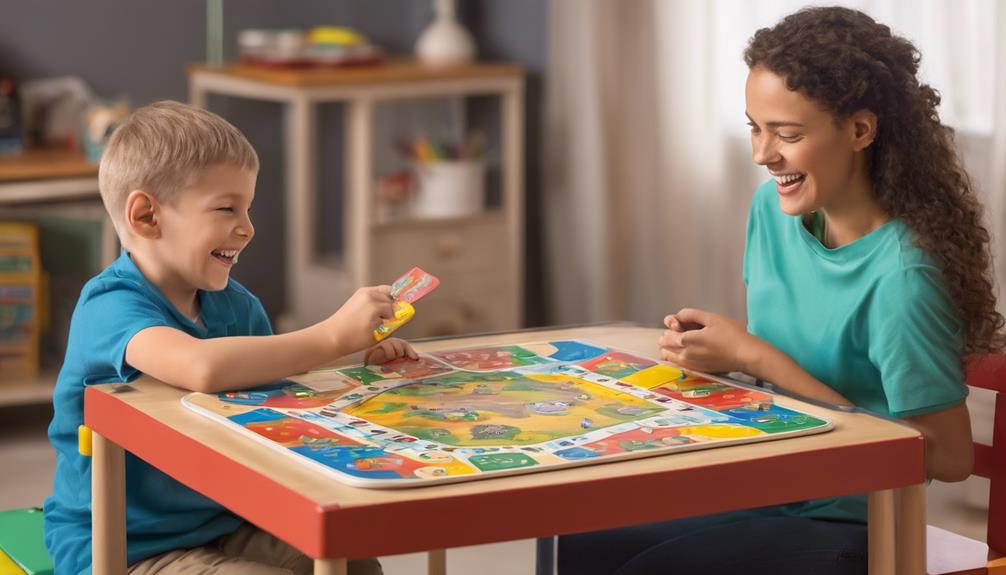Gamified therapy platforms keep kids engaged by turning rehab exercises into fun, game-like experiences that boost motivation. They use virtual reality to create immersive, safe environments where children practice skills and overcome fears. Rewards, instant feedback, and adaptive challenges help maintain their interest and prevent boredom. These platforms also allow you to monitor progress closely, making treatments more personalized and effective. Keep exploring to discover how these tools can transform rehab for your child.
Key Takeaways
- Gamified platforms transform therapy into engaging, game-like experiences, boosting motivation and making rehab enjoyable for children.
- Virtual reality creates immersive environments for safe skill practice and reduces therapy-related anxiety.
- Reward systems and instant feedback turn repetitive exercises into motivating challenges, encouraging sustained participation.
- Personalization and adaptive algorithms tailor difficulty levels to individual progress, maintaining optimal engagement.
- Monitoring tools within gamified platforms provide real-time insights, enhancing treatment effectiveness and long-term outcomes.

Have you ever wondered how technology is transforming mental health treatment? One exciting development is the use of gamified therapy platforms, which are particularly effective in keeping kids engaged during rehab. These platforms leverage the power of interactive design, turning therapy exercises into game-like experiences that kids find fun and motivating. Instead of viewing therapy as a chore, children see it as an adventure or challenge, which naturally boosts their enthusiasm and commitment to the process.
Virtual reality plays a significant role in these innovative platforms. It immerses kids in realistic, controlled environments where they can practice skills and overcome fears safely. For example, a child working on social skills might interact with virtual characters in a simulated social setting, making the experience both engaging and educational. These immersive experiences help make therapy less intimidating and more appealing, thereby increasing patient motivation. When kids are excited about participating, they’re more likely to stick with their treatment plans, which leads to better long-term outcomes.
Gamified platforms also incorporate rewards, points, and progress tracking, giving kids instant feedback and a sense of achievement. This immediate reinforcement encourages continued effort, transforming what might feel like repetitive or frustrating tasks into motivating challenges. As they earn points or access new levels, children feel a sense of mastery and progress, which fuels their desire to keep going. This approach taps into their natural love of games and competition, making therapy sessions something they look forward to rather than dread.
Another advantage of gamified therapy is that it can be tailored to each child’s specific needs and progress. Adaptive algorithms adjust difficulty levels based on individual performance, ensuring that kids are neither bored nor overwhelmed. This personalized approach keeps children in the ideal zone for learning and growth, maintaining their engagement throughout the process. Additionally, integrating creative practice techniques can enhance cognitive flexibility and emotional resilience, making the therapy even more effective. The use of virtual reality and game mechanics also allows therapists to monitor progress more precisely, providing insights that help refine treatment strategies.
Frequently Asked Questions
How Effective Are Gamified Platforms Compared to Traditional Therapy?
The question about effectiveness depends on your approach. Gamified platforms often provide a motivation boost by making therapy more fun and interactive. You’ll likely see higher engagement metrics compared to traditional methods, as kids stay involved longer and participate more actively. While traditional therapy has its merits, gamified options can enhance progress by maintaining interest and encouraging consistent practice, ultimately leading to better outcomes.
What Age Groups Benefit Most From Gamified Therapy?
Did you know children ages 6 to 12 show a 40% increase in engagement with gamified therapy? You’ll notice that this age group benefits most because of their high adaptability and love for interactive play. Their natural curiosity makes gamified platforms especially effective, boosting child engagement and motivation. As they develop, these platforms continue to adapt, ensuring therapy remains engaging and effective for various age groups.
Are There Any Risks Associated With Gamified Rehab Platforms?
You should consider that while gamified rehab platforms can boost motivation, there are risks involved. You might worry about data privacy, as personal health information could be vulnerable if not properly protected. Additionally, excessive screen time is a concern, potentially impacting your child’s sleep or physical activity. It is crucial to monitor usage and ensure the platform adheres to strict privacy standards to minimize these risks.
How Do Parents Track Their Child’s Progress on These Platforms?
Imagine holding a map that shows your child’s journey—progress tracking makes this possible. You can check detailed reports, monitor milestones, and see how they’re advancing over time. Parental involvement is key; many platforms offer real-time updates or summaries, so you stay informed and engaged. This way, you become an active guide, supporting your child’s rehab through clear insights and encouragement every step of the way.
What Technological Requirements Are Needed for Optimal Use?
You need compatible hardware like tablets or computers with good processing power and a reliable internet connection for ideal use. Make sure your device meets hardware compatibility requirements specified by the platform. Additionally, prioritize software security features to protect your child’s data. Regular updates and secure login protocols are essential. By meeting these technological needs, you guarantee a smooth, safe, and engaging experience that helps your child stay motivated during therapy sessions.
Conclusion
You can think of gamified therapy platforms as a playground for recovery, turning therapy into an exciting adventure rather than a chore. By keeping kids engaged and motivated, these platforms make progress feel like a game they can’t wait to play. Just like a spark ignites a flame, interactive games ignite kids’ interest in rehab, helping them stick with their goals. Embracing this approach can transform the rehab experience into something both fun and effective.











